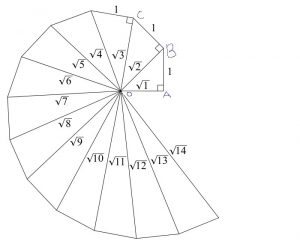Exercise 1.2
Question 1. State whether the following statements are true or false. Justify your answers.
(i) Every irrational number is a real number.
(ii) Every point on the number line is of the form m , where m is a natural number.
(iii) Every real number is an irrational number
Solution :
(i) True, All numbers are real number and they can be shown on number line
(ii) False, Every points on the number line are real number , they can be whole number , they can be fraction number
this is not necessary that they are natural number
(iii) False, Real number contains both rational number and irrational number
- ReadMore : Class 9th physics
Question 2. Are the square roots of all positive integers irrational? If not, give an example of the
square root of a number that is a rational number.
Solution:
No, square roots of all positive integers is not irrational because there are rational number also
example :
= 2 and 2 is rational number can be written as 2/1.
Question 3. Show how√ 5 can be represented on the number line
Solution:
To draw √5 we applying Pythagoras theorem

hypotenuse² = base²+height²
=22+12
=√4+1
=√5
consider 5 as radius and draw arc to line that meets point p.
P is the point represent the root 5.
Question 4. Classroom activity (Constructing the ‘square root spiral’) : Take a large sheet of paper and construct the ‘square root spiral’ in the following fashion.
Start with a point O and draw a line segment OP1 of unit length. Draw a line segment P1 P2 perpendicular to OP1
of unit length (see Fig. 1.9).
Now draw a line segment P2 P3 perpendicular to OP2 . Then draw a line segment P3 P4 perpendicular to OP3. Continuing in
this manner, you can get the line segment Pn–1Pn
by
drawing a line segment of unit length perpendicular to OPn–1.
In this manner, you will
have created the points P2, P3,…., Pn,… ., and joined them to create a beautiful spiral depicting 2, 3, 4, …
Solution:
following steps to draw
- Mark a center point O.
- From the point O, draw a horizontal line OA of length 1 cm.
- From the point A, draw a perpendicular AB of length 1 cm to the OA.
- Now, join OB, where OB = √2. ∵ Pythagoras theorem
- then, from point B, draw a line perpendicular to OB of length 1 cm. Mark the end point as C.
- Join OC, where OC = √3
- Repeat steps 4, 5, 6 for √4, √5, √6, …
- this is your square root spiral .

You can find the solutions for Class 6 Mathematics previous exercises from here
Tags: 9th class maths solution, 9th class ncert chapter 1 solution, 9th class maths solution chapter 1
